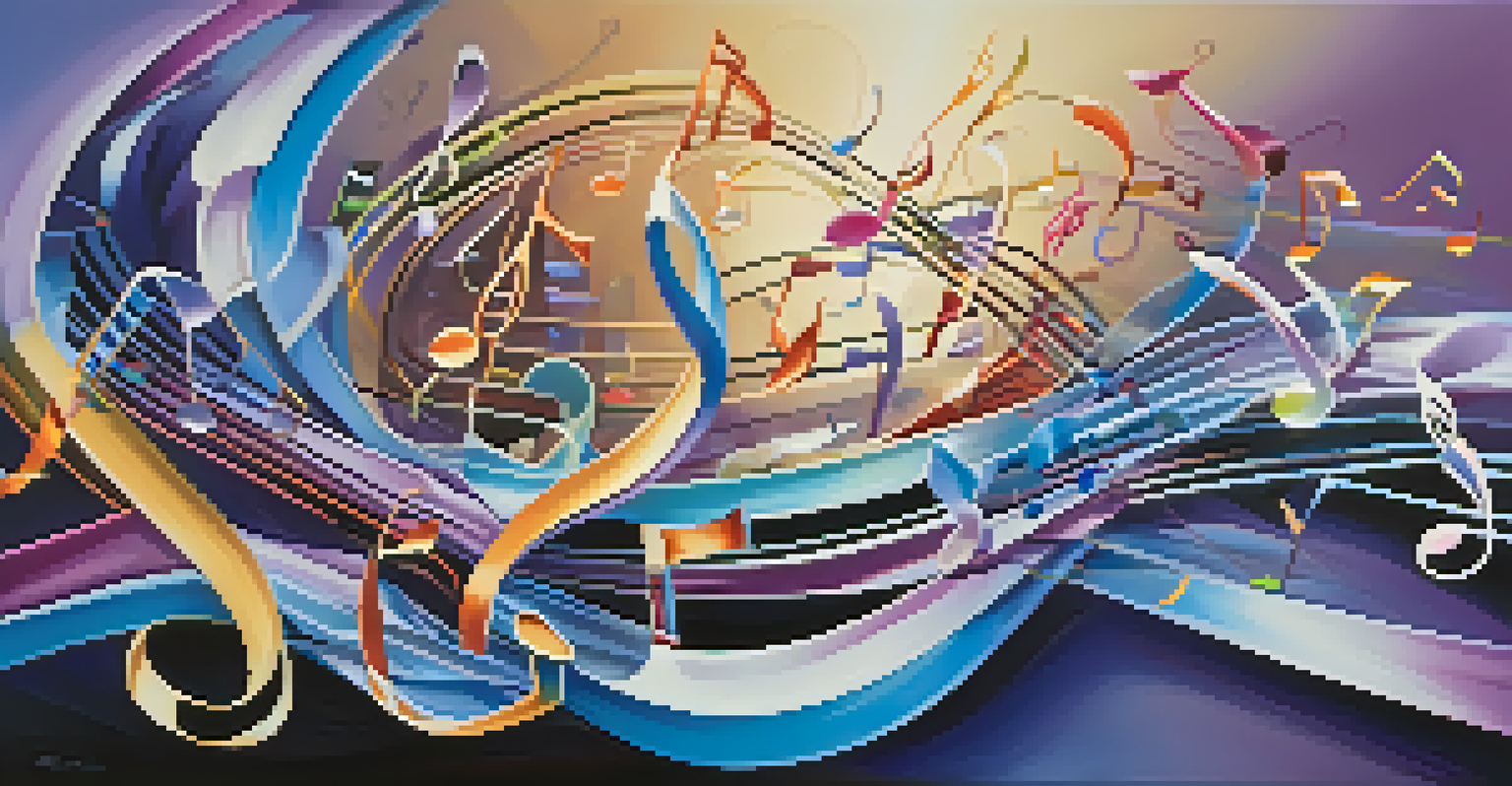The Emotional Impact of Melody in Music Composition

Understanding Melody: The Heartbeat of Music
Melody is often considered the soul of a musical piece, acting like a heartbeat that gives rhythm and emotion to the composition. It’s the sequence of notes that we hum, sing, or whistle long after the song has ended. Just like a good story, a melody can evoke feelings of joy, sadness, nostalgia, or excitement, making it a crucial element in music creation.
Melody is the essence of music; it is the heart that pumps life into a song.
When composers craft a melody, they aren’t just stringing notes together; they’re weaving an emotional narrative that listeners can connect with on a personal level. For instance, a rising melody can create a sense of hope, while a descending one might evoke feelings of loss or melancholy. This emotional connection is what makes melodies memorable and impactful.
In essence, melody serves as the primary vehicle for emotional expression in music. Whether it’s a catchy pop tune or a haunting classical piece, the melody is what lingers in our minds, reminding us of the emotions we felt while listening.
The Role of Rhythm in Shaping Emotional Responses
While melody is crucial, rhythm plays a significant role in how we perceive and feel about a piece of music. Think of rhythm as the pulse that complements the melodic line; it helps to create a sense of movement and energy. A fast tempo can evoke excitement and joy, while a slow tempo might bring about feelings of reflection or sadness.

For example, consider how a lively dance rhythm can lift your spirits and encourage you to move, while a slower, syncopated rhythm can create a sense of tension or anticipation. The interplay between rhythm and melody is what allows composers to craft unique emotional landscapes within their music.
Melody Evokes Deep Emotions
Melody serves as the primary vehicle for emotional expression in music, allowing listeners to connect with feelings of joy, sadness, and nostalgia.
Understanding this relationship is key for anyone looking to create emotionally resonant music. By thoughtfully combining rhythm and melody, composers can guide listeners through a journey of feelings, making their music not just heard but felt.
Melodic Contour: The Shape of Emotion
Melodic contour refers to the overall shape or direction of a melody as it moves up and down in pitch. This contour can significantly influence the emotional trajectory of a piece. For instance, a melody that rises gradually may evoke feelings of hope or triumph, while a melody that falls steeply can suggest sorrow or despair.
Rhythm is the pulse of music, guiding our emotions and movements.
Imagine a rollercoaster: the thrilling climbs and sudden drops mirror the emotional highs and lows found in a well-crafted melody. Composers often use these contours to create a musical narrative that resonates with listeners on a deep emotional level.
By mastering melodic contour, composers can enhance the expressiveness of their music, crafting pieces that not only tell a story but also elicit genuine emotional reactions from their audience.
Cultural Context: Melody and Emotion Across Genres
The emotional impact of melody is also influenced by cultural context. Different musical genres and traditions have distinct melodic structures that evoke varied emotional responses. For example, a traditional Irish folk tune might stir feelings of nostalgia and community, while a jazzy improvisation could inspire excitement and spontaneity.
This cultural lens shapes how melodies are perceived and felt by listeners. What may be considered a joyful melody in one culture might be viewed as somber in another. Understanding these cultural nuances can deepen a composer’s ability to connect with their audience.
Rhythm Complements Emotional Impact
The interplay between rhythm and melody creates unique emotional landscapes, guiding listeners through a journey of feelings.
As composers explore the emotional potential of melody, they can draw from a rich tapestry of cultural influences, creating music that resonates across diverse backgrounds and experiences.
The Power of Repetition in Melody
Repetition is a powerful tool in music composition, particularly when it comes to melody. When a melody is repeated, it can create familiarity, allowing listeners to form an emotional connection with it. This technique is often used in popular music to create catchy hooks that linger in our minds long after the song is over.
Consider how a simple, repeated melodic phrase can evoke a sense of comfort or nostalgia, reminding us of cherished memories. This is why many composers strategically use repetition to reinforce emotional themes within their music.
Ultimately, the art of repetition can transform a simple melody into an anthem that resonates with listeners, making it a key element in effective music composition.
Melody in Film: Crafting Emotional Narratives
In film, melody plays a crucial role in shaping the emotional landscape of a story. Composers create scores that enhance the visual narrative, using melody to highlight moments of tension, joy, or sadness. For instance, a soaring melody during a climactic scene can amplify the viewer's emotional response, making the moment more impactful.
Think about iconic soundtracks like John Williams' compositions for 'Star Wars' or 'Jurassic Park.' These melodies are not just memorable; they are intricately tied to the emotions and themes of the films, helping to convey the characters’ journeys and struggles.
Cultural Context Shapes Melody
Different cultural backgrounds influence how melodies are perceived, affecting their emotional resonance across genres and traditions.
By understanding how melody influences emotional narratives, composers can elevate the storytelling experience, making their music an essential part of the cinematic journey.
The Future of Melody in Music Composition
As music continues to evolve, so too does the role of melody in composition. With advancements in technology and the rise of new genres, composers have more tools than ever to experiment with melody and emotion. From digital production to artificial intelligence, the possibilities for creating emotionally resonant music are expanding.
Emerging artists are pushing the boundaries of traditional melodic structures, blending genres and incorporating diverse influences to craft unique emotional experiences. This innovation invites listeners to explore new sounds and feelings, enriching the music landscape.

Ultimately, the future of melody in music composition will likely be characterized by creativity and experimentation, allowing composers to connect with audiences in fresh and exciting ways.